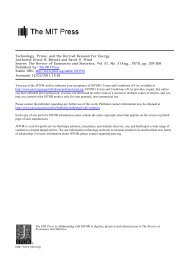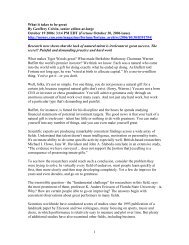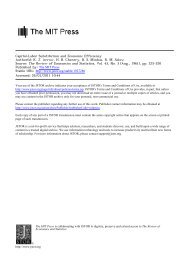Phan Coxhead Vietnam Wage Paper April 14 2011 - Agricultural ...
Phan Coxhead Vietnam Wage Paper April 14 2011 - Agricultural ...
Phan Coxhead Vietnam Wage Paper April 14 2011 - Agricultural ...
Create successful ePaper yourself
Turn your PDF publications into a flip-book with our unique Google optimized e-Paper software.
changes in government policies that affect state sector employment have the potential to shift the<br />
supply of skills, which also influences the private sector returns to schooling function.<br />
10<br />
This model is preliminary in nature and has many shortcomings (it is, for example, static, and imposes a<br />
number of assumptions, among them competitive wage-‐setting in private sector employment). Its<br />
virtue is its simplicity; it draws attention to what are arguably the dominant sources of wage<br />
determination for private sector workers: their own characteristics (e.g., education); their marginal<br />
value product in employment which is affected by reforms such as trade liberalization, and changes in<br />
aggregate supply, including those resulting from policies affecting state-‐controlled employment.<br />
4. Sources of differential wage growth<br />
The <strong>Vietnam</strong> data show that between 1993 and 2008, wages and the skill premium rose substantially.<br />
But it is easy also to see that virtually all of the growth took place in the first decade of the reform era,<br />
and that with the sole exception of the college degree/no education ratio in year 2008, every measure<br />
of the premium declined after 2002. What is behind these contrasting trends? This is not an easy<br />
question to answer in an economy where rapid growth is causing many things to change at once.<br />
Moreover, <strong>Vietnam</strong>ese statistical sources on some variables (such as workers’ wages and employment<br />
by skills) are very difficult to reconcile with those providing other kinds of information, such as<br />
employment, output and profits at firm or industry level. Our approach in this study relies primarily on<br />
VHLSS sources. 8 This allows us to retain the richness of the individual data in VHLSS, at the cost of<br />
constraining somewhat our ability to characterize the determinants of the general equilibrium wage.<br />
Our solution is to consider the two types of policy innovations– those addressing labor and other<br />
conditions in government and state-‐owned enterprises, and reforms affecting the profitability of<br />
production of tradables versus goods for the home market– as exogenous treatments, the effects of<br />
which we measure against trends reflecting underlying economic growth and development and<br />
captured in the evolution of wages for a control group. This section describes the methodology and<br />
reports econometric results of hypothesis tests.<br />
4.1. Empirical methodology: triple difference estimator<br />
Our goal is to measure the effects of two policy “treatments” on wage growth and wage inequality.<br />
Because we have two independent treatments, we employ a triple difference (DDD) estimator. To<br />
measure the “treatment” effects of trade liberalization and domestic reform, we divide the sample by<br />
public and nonpublic sector, and also by tradable and non-‐tradable industries (see appendix B for a list<br />
of industries in each category). While labor market reforms could have affected workers in both the<br />
public and private sectors, the evidence presented in section 2 suggests that they had first-‐order<br />
impacts only on the public sector. Thus, in a single-‐treatment difference in difference (DD) analysis, we<br />
can think of public sector workers as the treatment group and private sector workers as the control:<br />
!"# !"#! ! = ! ! + ! ! ∗ !"#$2 ! + ! !!"#$%& ! + ! !!"#$2 ! ∗ !"#$%& ! + ! !! + ! !<br />
8 In related research currently in progress, we approach the same question via other sources such as Enterprise<br />
Surveys.







